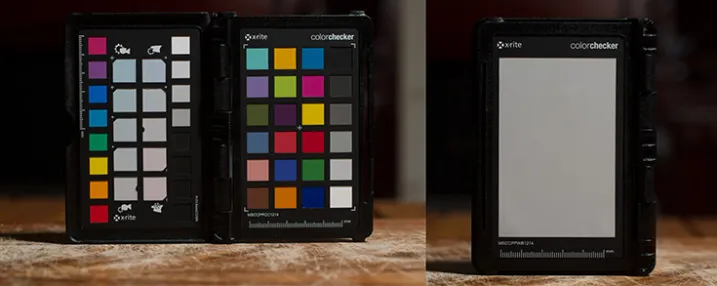Here’s A Quick Guide to Two Essential Tools in Film and Photography
In the mesmerizing world of film and photography, there are countless tools and techniques that help artists create stunning visuals. From the intricate settings on your camera to the perfect lighting setup, every detail plays a pivotal role in crafting that perfect shot. Among these tools are the often-underestimated heroes of the trade: the Color Checker and Gray Card. These seemingly simple devices are anything but ordinary, as they play a crucial role in achieving color accuracy, balance, and consistency. Let’s dive into the fascinating world of color calibration with these unassuming tools.
The Color Checker
Imagine a world where your reds look orange, and your blues look purple in your final photographs or film. It would be a nightmare for any photographer or filmmaker. The Color Checker, a compact and unassuming target with an array of squares in various colors, comes to the rescue.
The primary purpose of a Color Checker is color calibration and correction. It consists of a grid of colored squares, each one representing a known color under a standardized light source. Photographers and filmmakers include a Color Checker in their shot to provide a reference for post-production color correction.
The Color Checker ensures that the colors captured in your shot are true to life. This is especially important when shooting in different lighting conditions, as each lighting situation can affect how colors appear in your images. By including a Color Checker in your scene, you can easily correct and fine-tune colors during post-processing to maintain accuracy and consistency.
How to use a Color Checker:
- Capture the reference shot: When setting up your scene, include the Color Checker in the frame. Ensure that it is illuminated by the same light source as your subject.
- Adjust in post-production: During post-processing, use the Color Checker’s reference colors to correct the colors in your images. This helps you achieve the true-to-life colors you desire.

The Gray Card
If the Color Checker is all about correcting colors, the Gray Card focuses on perfecting exposure and white balance. It’s a simple, gray-colored card (usually 18% gray) that serves as a reference point for proper exposure and color balance.
The Gray Card is your go-to tool for achieving accurate and consistent exposure. When you place it in your scene, you can meter your camera to ensure that the gray card reflects the appropriate amount of light, allowing you to achieve a well-exposed image. In addition to exposure, it also assists in setting the correct white balance.
How to use a Gray Card:
- Place the gray card: Position the gray card in the same lighting conditions as your subject, ensuring it is illuminated by the same light source.
- Meter the gray card: Use your camera’s light meter to measure the light falling on the gray card. This sets your exposure accurately.
- Set white balance: In addition to exposure, the gray card can also be used to set the correct white balance in post-processing.
By utilizing a Gray Card, you can ensure that your images or footage have the right exposure, making them neither too dark nor too bright. This can be a lifesaver, especially in challenging lighting situations.
In the world of film and photography, where precision and consistency are paramount, the Color Checker and Gray Card are essential tools. They enable photographers and filmmakers to maintain color accuracy, balance, and exposure consistency across a variety of lighting conditions. Whether you’re capturing a breathtaking landscape, a portrait of a loved one, or a cinematic masterpiece, these unassuming tools can make a world of difference in the final result.
So, the next time you’re out in the field or setting up your studio, don’t forget to carry your Color Checker and Gray Card. They may be small, but their impact on the quality of your work is immeasurable.
Thank us later, and dont forget to tag us in your work!


Leave a Reply